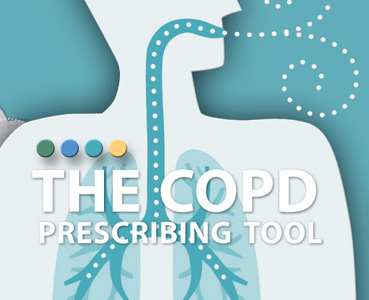 View / Download pdf version of this article
View / Download pdf version of this article
Dr Ben Brockway is a consultant in respiratory medicine and senior lecturer at the Dunedin School of Medicine.
 For further information see:
For further information see:
“Newly-subsidised medicines for the treatment
of patients with COPD", BPJ 74 (Mar, 2016).
1. These new medicines for COPD are confusing. How do you decide what to prescribe for each patient?
They appear confusing at first, but it gets much easier if you consider two things:
- The class of medicine you wish to use, and
- The type of inhaler device you want.
The new medicines are still divided into the same classes – long-acting muscarinic receptor antagonists (LAMAs), long-acting
beta2 agonists (LABAs) and a new once daily inhaled corticosteroid (ICS).
The key to which of these classes to use can be found in the GOLD classifications in Table 1. At
first glance these again look confusing, but they boil down to making assessments of how “bad” the patient is,
i.e. symptoms and/or spirometry, and how often they exacerbate. The online tool helps make these assessments.
Symptoms can be readily measured – for instance with the COPD Assessment Test (CAT) or a similar metric.
As a rule-of-thumb, long-acting bronchodilators are preferable for symptom relief in patients with anything other than
mild disease. As the patient’s symptoms worsen, one long-acting agent can be added to another – and indeed can
be combined in the same inhaler. Thus, patients with moderate or severe breathlessness may be on both a LABA and a LAMA.
Patients with multiple exacerbations per year and severe airflow obstruction may benefit from an ICS as well. The role
of inhaled steroids is currently under intense debate, as across the class they are associated with a rise in
incidence of pneumonia when used by patients with COPD. It is reasonable to suggest that ICS treatment in COPD
is decreasing and their precise role may be better defined in the future – perhaps on the basis of a biomarker
such as eosinophilia, in blood or sputum, or exhaled nitric oxide. Data for these approaches, however, are currently
contradictory. This is not the case in asthma, however, where they remain the bedrock of treatment.
It is also worth reiterating that all patients should have a short-acting reliever, usually a SABA, i.e. salbutamol
or possibly terbutaline. It is not wise to prescribe ipratropium (SAMA) containing medicines, e.g. Atrovent or Duolin,
if the patient is also using a LAMA such as tiotropium, umeclidinium, or glycopyrronium as they may compete for the same
muscarinic receptor binding sites and reduce efficacy.
There is no current convincing evidence to favour any of the new medicines in each class over their competitors.
Table 1: GOLD patient classification.
| Patient category |
Characteristics |
Exacerbations per year |
Spirometric classification |
mMRC |
CAT |
A |
Less symptoms: low exacerbation risk |
≤ 1 not leading to hospitalisation |
GOLD 1–2
FEV1 ≥ 50% predicted |
0–1 |
< 10 |
B |
More symptoms: Low exacerbation risk |
≤ 1 not leading to hospitalisation |
GOLD 1–2
FEV1 ≥ 50% predicted |
≥ 2 |
≥ 10 |
C |
Less symptoms: high exacerbation risk |
≥ 2, or 1 requiring hospitalisation |
GOLD 3–4
FEV1 < 50% predicted |
0–1 |
< 10 |
D |
More symptoms: high exacerbation risk |
≥ 2, or 1 requiring hospitalisation |
GOLD 3–4
FEV1 < 50% predicted |
≥ 2 |
≥10 |
 For further information see: “Upfront:
Are blood eosinophil counts helpful in predicting patient responses to inhaled corticosteroids in COPD?”, BPJ 74
(Mar, 2016).
For further information see: “Upfront:
Are blood eosinophil counts helpful in predicting patient responses to inhaled corticosteroids in COPD?”, BPJ 74
(Mar, 2016).
2. Do you have any potential safety concerns with the introduction of the new medicines?
There is a dearth of high quality safety data for all the medicines used to treat patients with COPD, although some
specific agents have been studied in select populations, e.g. tiotropium in the TIOSPIR (Tiotropium Safety and Performance
in Respimat) study.1 Nonetheless, direct safety studies often exclude just the type of multi-morbid patients
whom we typically see with COPD. The short answer therefore is that we do not see much difference in safety profile between
the new medicines and the existing ones as yet, but the whole area is in need of more study at a national/population level.
3. Are there any specific groups of patients who are likely to benefit from a change to one of the new medicines?
From a patient perspective, the biggest change they would see with the new inhalers are the inhaler types and the shift
to once daily dosing. So patients who sometimes struggle to remember to take the 12-hourly medicines may be happy to have
a once daily alternative.
The new inhalers include a combination not previously available: the LABA/LAMA combinations.
- Indacaterol/glycopyrronium (Ultibro Breezhaler)
- Umeclidinium/vilanterol furoate (Anoro Ellipta)
- Olodaterol/tiotropium (Spiolto Respimat)
These were initially positioned for patients with a lot of symptoms but not too many exacerbations i.e. GOLD group B,
but recent information from a trial investigating the effect of indacaterol/glycopyrronium versus fluticasone/salmeterol
on exacerbation rates in patients with moderate to very severe COPD (the FLAME trial) suggests they are also
effective at reducing exacerbation frequency.2 A LABA/LAMA combination is therefore a reasonable starting point
for patients in GOLD groups B and C and may be an acceptable choice in D as well. However, note that the Special
Authority criteria for the LABA/LAMA classes states that the “patient has been stabilised on a LAMA”, so they
must have been given tiotropium, glycopyrronium, or umeclidinium previously before commencing a combination LABA/LAMA.
4. There are some new types of inhaler devices now available. How do you work out which inhaler is best for your patient? Are some devices easier to use than others?
First up, none of the new devices can be used with a spacer. As always, you will need to carefully instruct the patient
and check their inhaler technique regularly. Just giving out a script is a recipe for failure and runs the risk of patients
losing faith in the new device.
- The Ellipta device is preloaded and chunky, so a reasonable choice for those with limited manual dexterity.
- The Breezhaler devices are similar in design to tiotropium handihalers: the active medicine capsule must be taken
from the foil pouch and placed in the device, pierced and inhaled (and definitely not swallowed!). Because the capsules
are transparent they can be visually checked to see that all the medicine has been inhaled.
- The Respimat device is initially tricky to prime – the cartridge that contains the active ingredients is loaded into
the base and requires some strength – but once loaded the device is good for four weeks and requires very
little inspiratory flow. I look upon this device as being a good choice for patients in supported environments such as
residential homes.
All of the new devices are renewed with each prescription and as none are recyclable they are disposed of in the household rubbish.
5. Do you have any suggestions for reducing patient confusion when prescribing medicines for COPD?
Firstly, I suggest minimising the different types of inhaler devices for each patient. Bear in mind that many will still be using a salbutamol metered dose inhaler (MDI),
so try and stick to one new device only. More device types means more confusion! If you are sure a once daily ICS is needed, then the only once daily medicine on the market
is the vilanterol/fluticasone furoate combination in the Breo Ellipta formulation; so if a LAMA is needed as well then stick to the Ellipta range by adding umeclidinium
(Incruse Ellipta). I struggle to see much point in a patient using, say, a once daily LABA/LAMA and a twice daily ICS.
6. Sometimes it’s hard to know when to refer patients with COPD. At what stage would you like to see COPD patients in your respiratory clinic?
An excellent question. Almost all patients with anything but the mildest disease should be considered for pulmonary
rehabilitation. Depending on local protocols I would recommend this be a priority. Most of the studies suggest
that pulmonary rehabilitation gives three or four times the improvement in quality of life that one of these
“fancy pants” new inhalers does. In terms of respiratory clinic assessment, this is recommended for patients
in whom there is diagnostic uncertainty (especially if there are concerns about malignancy, coexistent fibrotic
disease or bronchiectasis), those in whom long-term oxygen is considered, and those in whom assistance or guidance
is needed for advanced care planning.
7. What do you think is the most important point to remember when caring for patients with COPD?
Inhalers are just a small but helpful component of COPD management, and it is easy to “take your eye off the ball” by
stressing about inhaler options when the interventions that make a big difference, i.e. smoking cessation and
pulmonary rehabilitation, are the keystones of treatment. These patients are often complex, multi-morbid and generally
have a high burden of disease, and deserve the best of care.

New medicines, new combinations, new inhaler devices and changes to Special Authority approval, have transformed the range of subsidised medicines
for patients with COPD in New Zealand. But with change can come confusion.
bpacnz has created an online prescribing tool to help you and your patients make sense of these changes and make the right treatment decisions.
To access this tool see http://bpac.org.nz/copd